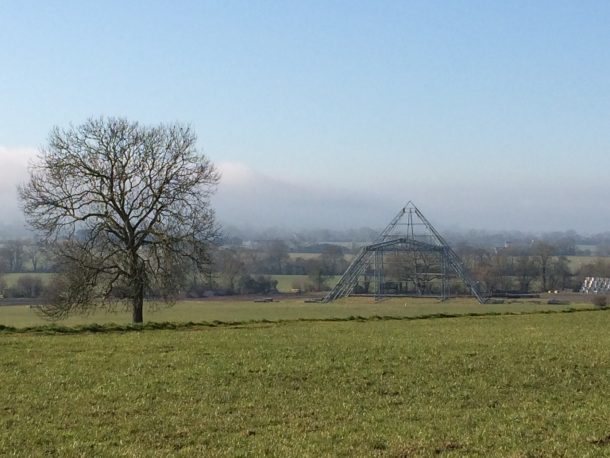Politics is the third and final theme of this year’s Prague Quadrennial of Performance Design and Space. Alongside music and weather, it is conceptualised as an ‘invisible scenography’ by the Artistic Director of the Quadrennial, Sodja Lotker. Much like more traditional conceptions of design and space, politics profoundly shapes our environment and our behaviour within that environment. It effects the way we plan our towns and design our buildings, such as the EUR in Rome, designed according to the fascist ideology which dominated Mussolini’s Italy. Politics also shapes the way we behave and the way we interact with other people.
A largely left-wing, Green politics pervades the present-day Glastonbury Festival, the origins of which can be traced back to the initial gathering in 1970. The topography of the festival site has long attracted people on the search for alternative narratives. The fields of Worthy Farm initially attracted festival goers for the nearby Tor and Abbey and their long-standing mythical associations with Joseph of Arimathea, the legend of King Arthur and the Holy Grail, the signs of the Zodiac and leylines. The latent mystical power perceived in the landscape is seen to provide the perfect platform for reflection and debate, to share ideas, stories and social responsibility. In 1971, the first pyramid stage was built on a site above the Glastonbury-Stonehenge ley line, creating a very concrete link between the topography of the festival site and the scenography of the festival’s infrastructure.

From the festival’s very inception, this celebration of the site’s topography also translated into a celebration of nature, the countryside and all things ‘Green’. It is an area of incredible natural beauty whose ‘green and pleasant lands’ were encapsulated in William Blake’s famous poem ‘Jerusalem’, which explores the legend of Joseph of Arimathea and the Holy Grail. This strong Green politics was first given concrete expression in the festival’s support for the CND (Campaign for Nuclear Disarmament) in the 1980s. Profits from the festival were donated to the CND and when the Pyramid Stage was rebuilt in 1981 the CND symbol took pride of place at the top. The festival is still an important part of the CND’s campaigning calendar. Now the three central “Worthy Causes” are Greenpeace, Water Aid and Oxfam and their presence is felt across the festival site.
The focal point for the festival’s ‘Green’ politics is the Green Fields. Described as ‘60 acres of quiet optimism, keeping alive the vision and principles that have inspired Glastonbury since the first gathering at Worthy Farm 44 years ago’ on the festival website, the Green Fields came into being in 1984. The green and sustainable ethos is echoed in festival policies, which encourage festival-goers to recycle, reward them for travelling to the festival by public transport through the Green Traveller Scheme and ask them to repect the ‘Love the Farm, Leave No Trace’ campaign. Last year Michael Eavis installed the largest privately owned solar PV array in the UK on top of the cattle shed and his first foray into renewable energy came in 1994 when he installed a wind turbine beside the main stage. Glastonbury has invested greatly into infrastructure to facilitate this Green politics and, in keeping with the Green-theme, is keen to use local suppliers and service providers whenever possible.
Left wing politics is at the heart of the festival site, both ideologically and structurally. The Left Field moved to its current position, slap-bang in the middle of the site, in 2010. The focal point is the 21-metre high Left Field Tower, which is the most distinctive structure in the Glastonbury skyline. In 2014 the Left Field Tower was renamed in honour of Tony Benn, politician, speaker and friend of the festival, who died in March of that year. The tower was built in 2004 by GMB apprentices from the Appledore shipyard in Devon, who were fighting against the threat of closure. A short film about the construction of the Left Field Tower can be found here.
Politics shapes and is shaped by the festival’s topography and infrastructure. Back in 1970 idealistic visionaries were first attracted to the site, both for its natural beauty and latent mystical potential. This has since translated into the way in which the festival is curated and the causes it supports, making politics part of the very fabric of the festival.
***
On 27 May 2015 the V&A’s installation Glastonbury: Land and Legend will open in Prague, Czech Republic. This will be the V&A’s contribution to the Prague Quadrennial of Performance Design and Space, taking place between 18 and 28 June 2015.



Thanks For This most amazing game website. i like the concept of games . this is the real a interested topic . its not a child game, there are any age person are play the game. if you are agree to press only single click to play the game.